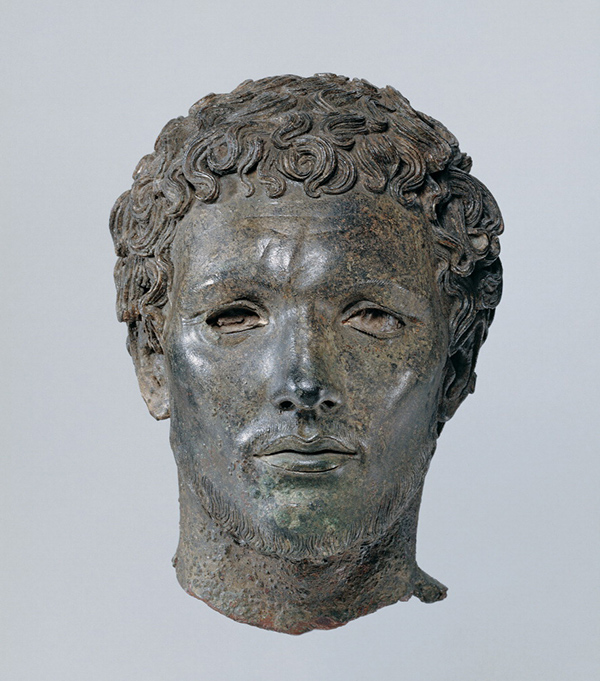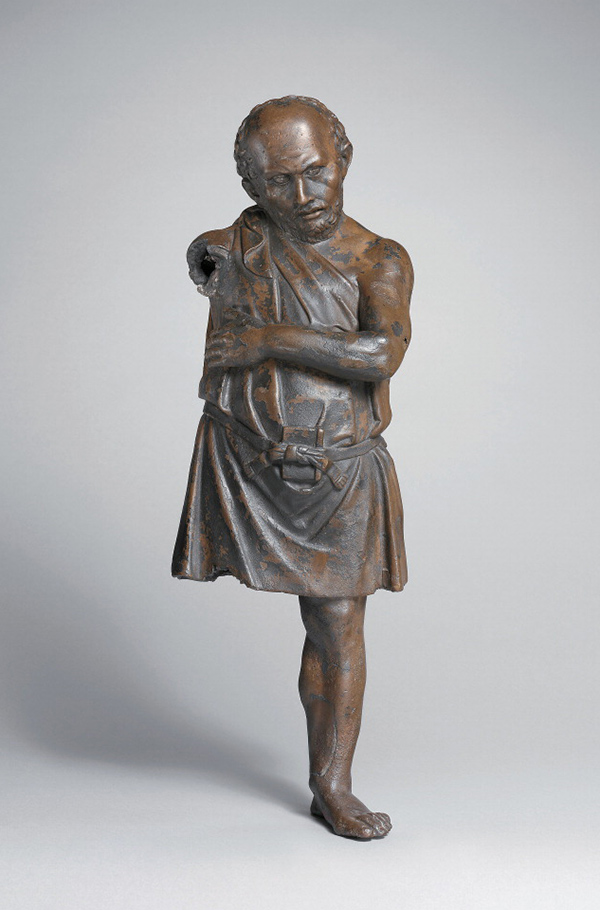
Portrait of a Man, about 100 B.C., found in Delos, Greece. Bronze, white paste, and dark stone, 12 13/16 in. high. The Hellenic Ministry of Culture, Education and Religious Affairs. The National Archaeological Museum, Athens, inv. X 14612. Photo: Marie Mauzy / Art Resource, NY
A portrait as we know it today—a glimpse not only of a person’s appearance, but of his soul or essence—came into being in the Greek world 2,300 years ago. During the Hellenistic period artists began to depict people as they seem to appear: imperfect, complex, and emotional.
Opening July 28 at the Getty Center (and then on December 13 at the National Gallery in Washington, D.C.) is the first major exhibition entirely devoted to ancient bronze sculpture of the Hellenistic period. Power and Pathos: Bronze Sculpture of the Hellenistic World assembles about 50 bronze figures and portraits, more than have ever been seen together since ancient times.
Getty Museum curator Kenneth Lapatin, who curated the show with colleague Jens Daehner and co-edited the accompanying book, walked me through some of the key points about these fascinating artworks and what makes them special.
In the Hellenistic period, Greek culture reached as far as India.
The Hellenistic period was the three centuries between the death of Alexander the Great in 323 B.C. and the beginning of the Roman Empire in 31 B.C. It was during this time that Greek culture reached its widest geographic extent.
Hellenistic sculptors excelled at capturing human emotion.
Experience and struggle became just as important as the beauty of the human form in the Hellenistic period. New levels of sophistication allowed detailed elements of the human form to be rendered in metal: veins, wrinkles, tendons, musculature, and naturalistic facial expressions. The Greek word pathos, meaning “lived” or “experienced,” expresses this concept.

Portrait of a North African Man, 300–150 B.C., found in Cyrene, Libya. Bronze and bone, 10 5/8 in. high. Image courtesy of © The Trustees of the British Museum
Hellenistic sculpture had emotional “formulas.”
In the Hellenistic period, artists were interested in more than just standard ideal figures. We see the first realistic images of children as children, not as miniature adults, and of older figures with balding heads and pot bellies.
The sculptures in the exhibition appear to be highly individual portraits—look at their furrowed brows, crows’ feet, bulging chins, broken noses, and fleshy cheeks. But because these features appear in more than one portrait, they appear to have been part of the artistic lingo of the time. How lifelike these portraits truly are is hard to say.

Sleeping Eros, 300–100 B.C., Greek. Bronze, 16 1/2 in. high x 33 9/16 in. The Metropolitan Museum of Art, Rogers Fund, 1943 (43.11.4). Image © The Metropolitan Museum of Art/Scala, Firenze

Artisan, middle of the 1st century B.C., found in Cherchell, Tipaza, Algeria. Bronze with inlaid silver, 15 7/8 in. high. The Metropolitan Museum of Art, Rogers Fund, 1972 (1972.11.1). Image © The Metropolitan Museum of Art/Scala, Firenze
Bronze lends itself to emotional expression.
Bronze sculpture is made with the lost-wax casting process, a technique that allows for finer detailing than stone carving. Because bronze is strong, metal sculptures could also have more dynamic forms than marble sculptures.
In ancient times, bronze sculptures were common.
In antiquity, bronze sculptures were made in multiples and extremely common. The lost-wax casting process allowed for many copies. Thousands of bare pedestals at archaeological sites show us that at one point bronzes were everywhere. Lysippos, sculptor to Alexander the Great, was reported to have made 1,500 bronze statues in his lifetime. None survive today.
Fewer than 200 bronze sculptures from the Hellenistic period survive.
Ancient bronze sculptures were melted down for their material, which was recycled into coins and other objects. Only 100 to 200 bronze sculptures from the Hellenistic period survive. The count varies, depending on how you want to count fragments like stray hands and feet.
Most of these bronzes survived by accident.
In a beautiful paradox, the bronzes we have today survived mostly because of disaster, such as volcanic eruptions and landslides. Greed also saved a few, since statues being transported as booty or commercial merchandise were sometimes submerged during shipwrecks. Just in the last 15 years, a handful of significant bronzes have been discovered at the bottom of the sea.
When first made, bronzes looked like human skin.
Today ancient bronze sculptures are various shades of green and gray, due to oxidation. But when first made they would have been a shiny, reflective brown, like tan skin in the Mediterranean sun.

Portrait of a Man, 200s B.C., found in Kalymos, Greece. Bronze, copper, and faience or alabaster, 12 5/8 in. high. The Hellenic Ministry of Culture, Education and Religious Affairs. The Archaeological Museum of Kalymnos, 3901. Copyright © Hellenic Ministry of Culture and Sports/Archaeological Receipts Fund
Hellenistic bronzes weren’t just made of bronze.
Just as the white marble sculptures of ancient times were once colorfully painted, bronze portraits, now hollow-eyed, were inlaid with colorful metals and other materials. Eyes, nipples, lips, teeth, garment hems, and more might have been detailed with gold, copper, silver, bone, ivory, stone, or glass.
Women became important portrait subjects for the first time in the Hellenistic period.
Queens, priestesses, and heiresses were all important public figures commemorated in sculpture during the Hellenistic period, a time with more examples of female portraiture than ever before in the classical world.

Medallion with Athena Wearing the Head of Medusa, 200–150 B.C., found in Thessaloniki, Greece. Bronze with inlaid white glass, 10 11/16 in. high. The Hellenic Ministry of Culture, Education and Religious Affairs. The Archaeological Museum of Thessaloniki, 17540. Image © Hellenic Ministry of Culture and Sports /Archaelogical Receipts Fund. Photo: Orestis Kourakis
______
Power and Pathos: Bronze Sculpture of the Hellenistic World is on view July 28 to November 1, 2015, at the J. Paul Getty Museum at the Getty Center. The exhibition was organized by the J. Paul Getty Museum, the Fondazione Palazzo Strozzi in Florence, and the National Gallery of Art in Washington with the participation of the Soprintendenza per i Beni Archeologici della Toscana. It is supported by an indemnity from the Federal Council on the Arts and the Humanities.




Comments on this post are now closed.